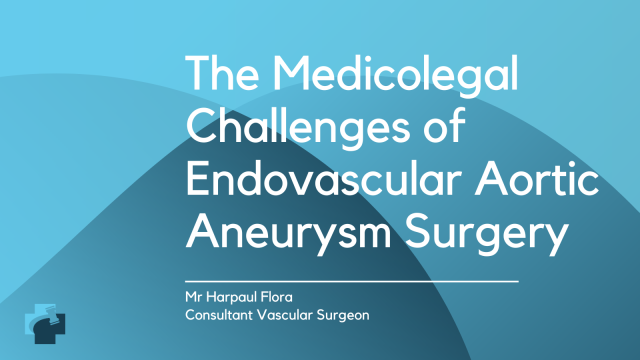A Medicolegal Perspective on Arterial Injury Following Joint Replacement

Arterial injury is an extremely rare consequence of joint replacement surgery. Estimates of its incidence range from 0.03–0.67%, with the average being around 0.25%. Therefore, many surgeons will only experience a handful of cases during their career. Despite its rarity, arterial injury is associated with high levels of both morbidity and mortality and can have a serious impact on the viability of the limb. Management of arterial injuries is complicated further by the fact that there is no clear consensus on the optimal course of treatment. Not surprisingly, around 50% of cases result in litigation.
Arterial injury may occur due to direct or indirect trauma. Direct trauma during drilling or pin placement can result in penetrating injury, laceration or transection of the artery. This presents as haemorrhage during surgery which needs to be dealt with immediately, or later complications such as pseudo-aneurysm, arteriovenous fistula or recurrent haemarthrosis. As these may occur some weeks after patient follow-up has ceased, they are likely to be underreported.
Indirect trauma may also lead to arterial injury. Damage to the lining of the artery or displacement of existing atheromatous plaques, through the use of tourniquets or by excessive manipulation of the joint during surgery, can result in thromboembolic complications, such as arterial occlusion. The risk of this is high as even minimal damage can accelerate existing atherosclerosis, although the effects can be delayed for a considerable length of time. Some complications have been reported up to two years after the original surgical procedure. The techniques required during joint replacement, including posterior retraction, hyperextension and hyperflexion of the joint, and exposure to sharp bony edges following osteotomy means that the associated arteries are at high risk of indirect injury.
Regardless of the nature of the injury, the consequences of arterial injury can be extremely severe. Mortality occurs in up to 10% of cases, and amputation of the affected limb may be required in around half of all patients. Compartment syndrome and foot-drop are also common and may require further surgery. Early diagnosis, which may prevent these conditions from developing, requires monitoring of the patient’s pre- and post-operative neurovascular status. However, the failure to document pre-operative pulse status in the majority of patients makes comparison difficult. Diagnosis is also made harder due to the non-specific nature of many of the symptoms associated with arterial injury, particularly in those conditions that arise some time after the surgical procedure.
The treatment of arterial injuries is complicated by the fact that there is no clear consensus on the best course of action. Patients who develop thrombosis may be treated with percutaneous thrombolysis, thrombus aspiration, thrombectomy, bypass surgery, or primary amputation. The options for pseudo-aneurysm include percutaneous management with thrombin injections, covered stenting, embolization or ultrasound-guided compression, or surgical excision and repair with either a vein patch or interposition graft. Ultrasound may be used to distinguish between pseudo-aneurysm and deep vein thrombosis (DVT), as it is important that anticoagulation therapy is avoided if a DVT is not present.
Given the difficulty of treatment and the potentially catastrophic consequences of arterial injury, prevention is vital. The risk of direct injury to the artery is mainly associated with poor surgical technique, so careful technique provides the best way of reducing the incidence of this type of trauma. Indirect injury can be avoided by conservative manipulation of the joint during surgery, which should be carried out with the joint in flexion. Although pneumatic tourniquets are commonly used, the risks and benefits they offer must be carefully weighed up. The advantages of tourniquet use include a cleaner operating site and improved bone-to-cement bonding. However, they are also associated with a high risk of neurovascular injury. Restricting the duration of tourniquet use, or the pressure exerted, may not be sufficient to avoid arterial injury, as thrombotic complications have been reported after only 10 minutes of usage.
A number of pre-operative factors also influence the risk of arterial injury. These include peripheral arterial disease, presence of an arterial bypass graft, arterial calcification visible on plain radiograph and revision surgery or previous surgery near the affected joint. Revision surgery is particularly risky, with the chance of arterial injury being approximately double that of primary surgery. This may reflect the fact that the artery is likely to be fixated closer to the joint by scar tissue from the original surgical procedure, leading to an increased susceptibility to both direct and indirect trauma. Anatomical abnormalities, such as dysplasia, congenital dislocation, previous fractures or anatomical changes arising from muscle wastage and scarring are also associated with higher levels of arterial injury, as are bone anomalies, such as Paget’s disease, osteoporosis, rheumatoid arthritis and osteitis. Therefore, pre-operative assessment should include both radiography, arteriography and venography, with cross-sectional techniques such as CT or MRI, to precisely define the relationship between the relevant anatomical features and the vascular system.
Joint replacement is usually carried out to improve the patient’s quality of life. Although rare, arterial injury is a serious consequence of this procedure and can have a significant impact on the patient’s physical and psychological health. However, the risk of injury can be reduced in a number of ways through good planning. Furthermore, early diagnosis and treatment is vital to ensure a successful outcome and reduce the risk of litigation.
Further reading:
Pal A, Clarke JM, Cameron AE. Case series and literature review: popliteal artery injury following total knee replacement. Int J Surg. 2010;8(6):430-5.
Riouallon G, Zilber S, Allain J. Common femoral artery intimal injury following total hip replacement. A case report and literature review. Orthop Traumatol Surg Res. 2009 Apr;95(2):154-8.




